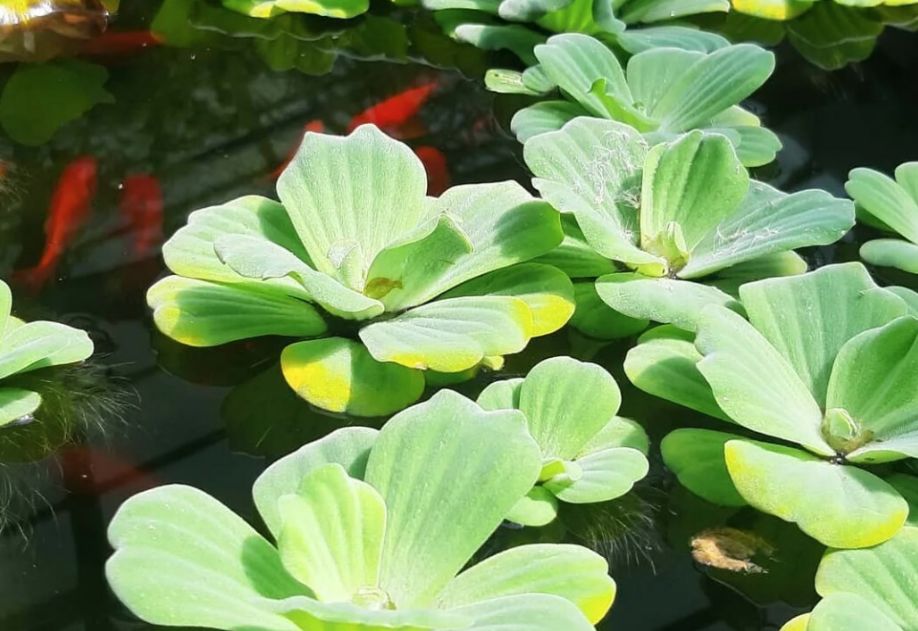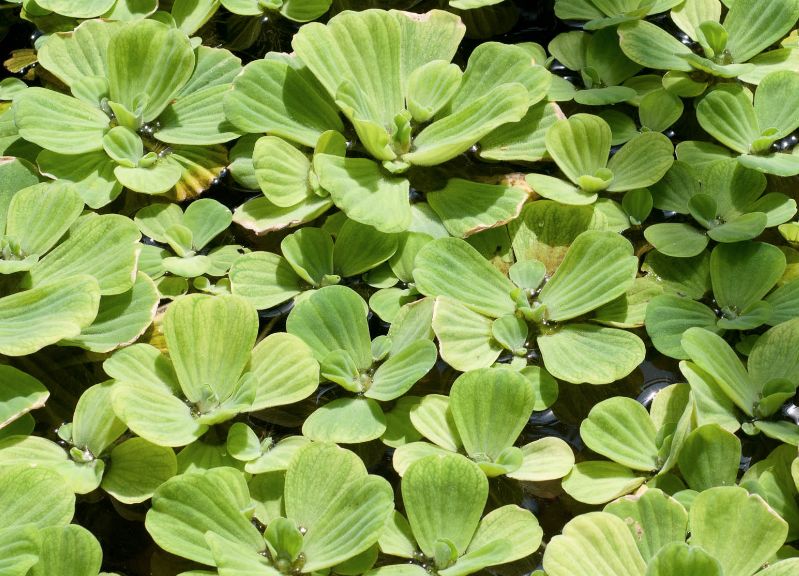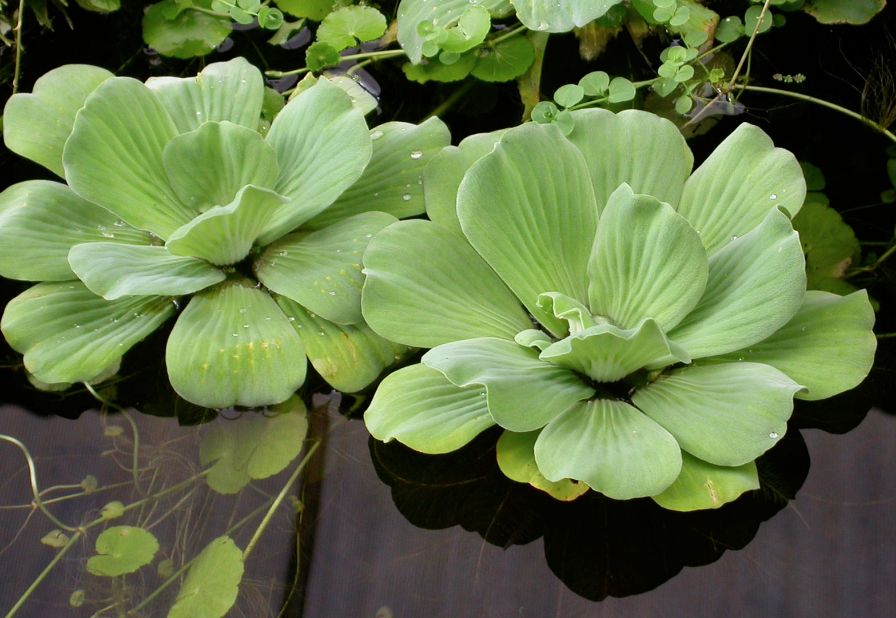Water lettuce is a floating aquatic plant that thrives in tropical and subtropical regions, renowned for its striking appearance and minimal care requirements. This plant not only enhances the visual appeal of aquariums but also provides significant ecological benefits, such as improving water quality by absorbing excess nutrients and providing shelter for small fish.

Contents
Habitat in the wild
Water lettuce is a unique member of the Araceae family, represented solely by the species Pistia stratiotes. This visually appealing aquatic plant has gained popularity among aquarists due to its ease of care and attractive appearance.
The name “Pistia” derives from the Greek word ‘pistis,’ meaning ‘water,’ which is reflected in the plant’s common names, including water lettuce, Nile cabbage, and shellflower. Its upper leaves bear a resemblance to young lettuce, contributing to its charm in aquariums.
Native to South America and the Caribbean, water lettuce is believed to have originated in South Africa. Today, it can be found globally, thriving primarily in tropical and subtropical regions, and is absent only in Antarctica. In its natural habitat, it flourishes in various freshwater environments such as ponds, lakes, slow-moving rivers, and marshes.
Water lettuce is a free-floating plant that forms dense colonies on the water’s surface. It has specialized structures, including air-filled spaces in its leaves and feathery roots that dangle beneath the water, allowing it to float effortlessly. This adaptability enables it to thrive in nutrient-rich environments, particularly in areas impacted by agricultural runoff or sewage discharge, where elevated nitrogen and phosphorus levels promote rapid growth.
However, water lettuce has become invasive in many parts of the world outside its native range. When introduced into new ecosystems, it can spread rapidly, outcompeting native plant species. The dense mats it forms can block sunlight, deplete oxygen levels, and disrupt the natural balance of aquatic ecosystems. Invasive populations of Pistia stratiotes have been documented in Australia, the USA, Puerto Rico, and South Africa, and it has also been identified in several European countries over the last 20 years. In the United States, water lettuce became widespread by the mid-1700s.


Description
The leaves of water lettuce form a floating rosette, with intercellular spaces filled with air, allowing the diameter of this rosette to reach up to 25 cm (10 inches). Water lettuce has developed several adaptations to thrive in its floating lifestyle. The leaves are covered with short grayish filaments that act as a protective barrier, preventing water from saturating them, while their sponge-like structure filled with air cavities facilitates buoyancy. Additionally, the leaves feature a waxy coating that helps minimize water loss.
On the underside, the leaves exhibit a silvery-green hue with distinct longitudinal veins. Each leaf can grow up to 15 cm (6 inches) long and 8 cm (3 inches) wide. When considering the entire plant, including its roots, the length can vary between 15 cm (6 inches) and 30 cm (12 inches).
Water lettuce also possesses numerous floating feathery roots. Initially light-colored, these roots gradually develop a bluish or even black hue as they mature. The roots can extend up to 20 cm (8 inches) long. Typically, these roots remain submerged, but in shallow waters, the plant can anchor itself by sending roots into the substrate. With a strong suction force, the roots are effective at filtering water, removing toxic impurities, including heavy metal salts.
Water lettuce reproduces both sexually and asexually. It produces small, inconspicuous flowers that are pollinated by wind or insects. Following pollination, small fruits containing seeds develop. Additionally, the plant generates daughter plants or runners that detach and float away, establishing new colonies.
| Characteristic | Description |
|---|---|
| Scientific Name | Pistia stratiotes |
| Common Name | Water lettuce |
| Habitat | Tropical and subtropical freshwater environments |
| Growth Form | Free-floating aquatic plant |
| Leaf Description | Rosettes of light green, spongy leaves |
| Root System | Feathery roots dangle beneath the water’s surface |
| Reproduction | Sexual (flowers and seeds) and asexual (daughter plants) |
| Temperature Range | 68°F to 86°F (20°C to 30°C) |
| Light Requirements | Moderate to high lighting |
| Water Movement | Prefers calm or stagnant waters |
| Nutrient Preference | Thrives in nutrient-rich environments |
| Invasive Potential | Can become invasive outside its native range |
| Ecological Role | Provides cover, shade, and habitat for aquatic organisms |
| Benefits | Absorbs excess nutrients, oxygenates water, controls algae |
Water lettuce care in aquarium
Water parameters and temperature
Water lettuce is widely distributed in aquariums and thrives under artificial ceiling lights and high humidity. When provided with optimal conditions, the plant can grow year-round, although it tends to be smaller in size compared to those grown outdoors.
This adaptable plant grows well in both soft and hard water. A warm temperature and sufficient light are usually enough to produce healthy specimens. Notably, the specific characteristics of tank water, such as hardness and pH, do not significantly impact its growth. Water lettuce can flourish within a wide range of water conditions, tolerating a pH range of 5.9 to 8.4, with general hardness (GH) less than 25° and carbonate hardness (KH) less than 1.
However, if water hardness exceeds 12°, growth may be somewhat impaired. The plant stops growing when the pH falls below 5 and exhibits its best growth rates when the pH is close to 7. The ideal water temperature range for water lettuce is between 15°C and 35°C (optimal range is 22°C to 30°C, or 72°F to 86°F).
To prevent water lettuce from interfering with the growth of other plants in the aquarium, it is essential to monitor its population and thin it out periodically. By removing excess plants, you can maintain the health of the parent plant for up to a year and provide better light conditions for lower-growing plants.
Lighting
The length of light exposure for water lettuce should be at least 8 hours per day, with a preference for no more than 10 hours. Inadequate lighting can result in smaller growth, and new leaves may fail to rise above the water surface. Under unfavorable conditions, the leaves may even lie flat on the water. Conversely, when tank conditions are optimal, the leaves will rise above the water, showcasing the plant’s healthy growth.
CO2
CO2 supplementation is not typically necessary for the well-being of water lettuce in most aquariums. This plant is quite resilient and can thrive in a variety of conditions without the need for additional carbon dioxide. Water lettuce naturally absorbs carbon dioxide from the surrounding air.
Bottom substrate and root system
The root system of water lettuce can grow underwater, reaching depths of up to 30 cm (12 inches). However, it typically does not touch the substrate and remains suspended in the water, making the composition of the bottom substrate less critical for its growth.
The condition of the root system can serve as an indicator of the presence of necessary chemical compounds in the water. In environments where macro- and microelements are scarce, the root system tends to expand significantly, often at the expense of the above-water portion of the plant. This can result in a small rosette of leaves accompanied by a branched and extensive root system. Conversely, when the water is rich in nutrients, such imbalances are less likely to occur.
Thus, an overdeveloped root system may indicate nutrient deficiencies in the tank water. If this situation arises, consider increasing the amount of fertilizers added to the water or adding more fish to provide organic fertilizers, which will help restore balance to the plant’s growth.
Fertilizers
Water lettuce reaches its maximum size in tank water that is rich in nitrogen compounds. During the active growth period, it is beneficial to supplement the plant with compound fertilizers that include essential microelements. The recommended dosage of fertilizers is generally similar to that used for most aquarium plants, ensuring that water lettuce receives the necessary nutrients to thrive.
By providing adequate nitrogen and microelements, you can promote robust growth and a healthy appearance, allowing water lettuce to flourish in your aquarium environment.
Seasonal patterns
Water lettuce exhibits a distinct active vegetation period, which typically begins in spring as daylight increases. During this time, the plant produces a significant number of new leaves, with rosettes quickly growing to about 10-12 cm (4-5 inches) in diameter. However, as autumn approaches, the pace of growth slows considerably.
During the autumn and winter months, some leaves may die off, leaving only smaller leaves and roots to survive the colder season. This dormant period lasts about 2-3 months before another active growth phase begins.
In an aquarium setting, you can override this natural growth cycle by creating artificial conditions that promote active growth year-round. With the right lighting and nutrient levels, water lettuce can thrive continuously, allowing for consistent growth.
During this extended period of activity, newly developed plants can grow to match the size of the parent plant. Once the new rosettes reach about 5-6 cm (2 inches) in diameter, they can be separated from the parent plant and cultivated independently.

Benefits of water lettuce in an aquarium
Water lettuce in an aquarium serves not only as an attractive decoration but also as a beneficial plant for the aquatic environment.
Firstly, it actively consumes organic components dissolved in the water, functioning as a biological filter that helps decrease nitrate and ammonia levels. This process improves water quality, creating a healthier habitat for fish and other aquatic life.
Secondly, when heavy metal salts are present in the water, water lettuce can absorb and accumulate these substances in its tissues, effectively reducing their concentration to safe levels. This characteristic makes the plant particularly desirable in tanks with sensitive fish species that require specific water chemistry for optimal health.
Thirdly, the underside of the leaves and the thick roots of water lettuce provide excellent spawning substrates for fish that lay eggs near the water’s surface, such as bettas and dwarf gouramis. The structure of the plant offers a safe and nurturing environment for fish to reproduce.
Finally, these thick roots can serve as both shelter and a food source for the juvenile stages of many fish species, including platies and guppies. Many fish that feed on aquatic vegetation will eagerly consume the roots, benefiting from the additional nutrition.
Water lettuce is also welcome in terrariums, particularly for keeping red-eared sliders, which enjoy eating the plant’s roots and leaves, as well as axolotls, which are sensitive to water purity. In both settings, water lettuce contributes positively to the ecosystem by providing food and improving water quality.
Propagation
Water lettuce propagates both vegetatively and through seeds. However, in aquarium settings, it rarely blooms, making seed propagation uncommon in practice. Under favorable conditions, water lettuce primarily relies on vegetative reproduction, quickly growing stem shoots that allow for rapid expansion. This process is particularly accelerated in warm water with natural lighting.
Young shoots can be separated from the parent plant once they develop approximately 2-3 new leaves, at which point they are ready for independent growth. In the wild, after being separated from the parent rosette, these young shoots can be dispersed by water currents or animals, further aiding in the plant’s spread.
Due to its remarkable ability for fast vegetative propagation through stem shoots, water lettuce quickly forms a lush green floating cover on the water’s surface.
Invasive Potential
Water lettuce is considered a persistent weed due to its rapid growth potential, often capable of completely covering the surface of small water bodies in a short period. This extensive coverage can have detrimental effects on the aquatic ecosystem, as it significantly increases water consumption in the pond. The transpiration from water lettuce requires far more water than the evaporation from the pond’s surface, leading to reduced water levels.
The dense mat of leaves prevents sunlight from penetrating into the water, disrupting the photosynthesis of submerged plants. Additionally, the cover restricts atmospheric oxygen from reaching the water, which can lead to the death of various aquatic organisms. The root system of water lettuce contributes to the silting of the pond, making the substrate unsuitable for fish spawning and creating ideal breeding conditions for mosquitoes, thereby promoting their population growth.
Water lettuce can migrate over large distances, facilitated by birds that carry both its seeds and vegetative parts. In Africa, the plant often moves downstream with river currents, and similar dispersal occurs in India and South America. Human activity has also played a role in its expansion; water lettuce was initially cultivated as a medicinal plant and later discarded into local ponds, further contributing to its proliferation.
Like other floating plants, water lettuce has significant biomass proliferation potential. This high productivity and nutrient efficiency are being explored for various applications, including methane production and animal fodder. However, the plant’s tendency to accumulate heavy metals in its tissues limits its use as animal feed.
Additionally, the decomposing biomass of water lettuce is sometimes employed in bioremediation efforts to remove metal contaminants from industrial waste. Effective management of water lettuce involves harvesting it mechanically from the water’s surface and transporting it to dry land. In tropical regions, the harvested greenery can be used as fodder for livestock, including cows and pigs. Beyond mechanical methods, chemical and biological strategies are also employed to control the plant’s spread and minimize its impact on local ecosystems.
Sources: